Grand Seiko Spring Drive Snowflake SBGA211
Because Spring Drive isn't just a quartz movement...
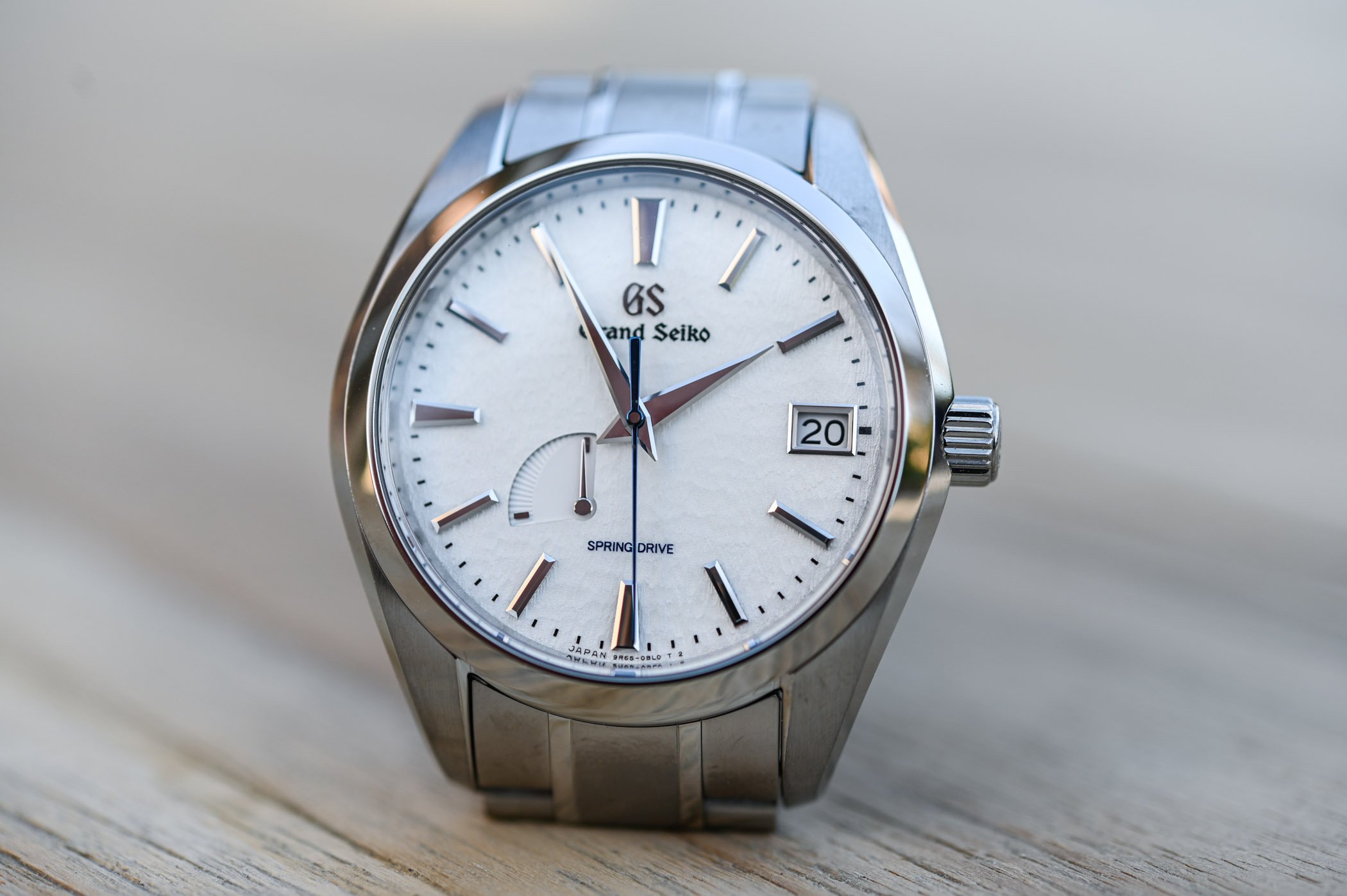
Quartz… A word that you don’t often read on MONOCHROME. I’m not afraid to say that and freely admit that we are watch snobs. We love fine mechanics and Haute Horlogerie. However, the watch that we’re about to review has a quartz regulator, but isn’t battery powered – and that already makes things slightly different. Secondly, this watch is made by Grand Seiko – and we’ve already seen that it is committed to doing things in a different (better?) way. And last but not least, this quartz crystal is part of a hybrid movement, mixing old-school mechanics and modernity. This watch is the Grand Seiko Spring Drive Snowflake SBGA211 and no, we’re not afraid to review it in this “online magazine dedicated to fine watches”.
I recall that following his visit to the Seiko manufacture, our founder Frank Geelen came to the conclusion that: “Quartz CAN be high-end”. A concept that will be important to this article because, as Frank pointed out in his article, antipathy towards quartz has always prevailed: “Quartz is despicable. Quartz caused the infamous quartz crisis during which many Swiss watch brands got in trouble, or even went bankrupt. Emotions towards quartz are usually pretty negative, and in the Swiss watch industry, the words quartz and high-end will not be mixed easily.” This is a fact! And to make things worse, quartz usually appears in tandem with the word battery – and that’s where we usually stop looking at such watches.
A Quartz watch on MONOCHROME…?
One company decided that quartz didn’t necessarily have to be low-end. That it can even be pretty fascinating in terms of watchmaking expertise – as long as you believe in modernity (something that was a prerequisite for today’s article). In 2004, Grand Seiko introduced a technology named Spring Drive where 80% of the movement’s components are shared with a mechanical watch, with no battery, and where energy is supplied from a mainspring and the motion of the hands results from a gear train. The only difference is that the regulating organ isn’t a classic balance/escapement module but an electronic regulator combined with a quartz crystal. The icing on the cake? Grand Seiko produces its quartz crystals in-house.
With this introduction, the door is now open for us to have a look at the Grand Seiko Spring Drive Snowflake SBGA211. For once, we’ll leave our snobbery in the closet and we’ll give Spring Drive technology a chance – well, in fact, we’ve been convinced by it for a long time now! In all objectivity, this Snowflake SBGA211 deserves some attention and offers an array of incentives to conquer the EUR 5K to 10K category. So let’s look at it in detail.
Case and bracelet
For once, I’m going to start a review with the bracelet. Why? I often read (and I even said it myself) that Seiko and Grand Seiko’s metallic bracelets are not on par with competing watches. Reality is that it was sort of true and some of the watches can have rather flimsy bracelets. If you look for instance at Rolex or Omega, their modern bracelets are pretty impressive, whether for their finishing, the precision of the assembly, the comfort or the overall durability. Knowing that most Grand Seiko watches are in the EUR 5K to 10K category, these are direct competitors. Confrontation is inevitable.
In the case of the Snowflake SBGA211, we have a full high-intensity titanium bracelet combining satin-finished surfaces and polished accents. Quality-wise, this is objectively a very well-executed bracelet. Comfort-wise, the fact that titanium is much lighter than steel makes this bracelet a pleasant ally on a daily basis – in addition to the fact that titanium is very soft on the skin, and that the links are quite thin. Whether for the quality of the assembly, the precision of the machining, the execution of the finishing or the comfort, the bracelet of the SBGA211 is on par with the rest of the contenders in this category. End of debate? Not quite.
There’s one shortcoming and it involves the adjustment of the bracelet. While Rolex and Omega have adopted a construction with removable links connected by screws, Grand Seiko sticks to classical pins, making it no less solid but rather difficult for self-adjustment. In an era where e-commerce is fast developing, such a construction means that, unless you have the required tools, you’ll still have to go to a watchmaker to fit your bracelet. Other than that, no complaints regarding this titanium bracelet fitted on the SBGA211 and its butterfly clasp with security pushers.
Moving on to the case, Grand Seiko’s reputation is not up for debate. The Spring Drive Snowflake SBGA211 has a high-intensity titanium case with satin-finished and polished surfaces done in the usual (superb) GS way. All the surfaces are precisely defined, the demarcation lines are extremely sharp. The sides of the case and bezel are mirror polished with the typical Zaratsu technique (an ancient method of hand-polishing used on Japanese fighting swords) creating a distortion-free mirror finish. It might be a detail that only trained eyes will spot… but beauty resides in details.
The shape of the case is also typical Grand Seiko, with robust casebands, integrated lugs (continuous line from one lug to another) and overall dynamic lines. The crown is slightly recessed for protection and large enough to be manipulated with ease. The Grand Seiko Spring Drive Snowflake SBGA211 has contemporary proportions without being overly done. With its 41mm diameter and its 12.5mm height, it is in line with competing watches (think anything steel/sports Rolex or Aqua Terra by Omega). The main advantage of this piece is its weight – approx. 100 grams, compared to the 150+ grams of a Submariner.
Combine the impressive attention to details with the lightness and scratch-resistance of titanium, and you end up with a very serious watch. This SBGA211 isn’t an ostentatious watch. It does things in a discreet way, with a casual, all-rounder look. However, once you wear it, you’ll quickly understand that you have a true luxury piece on the wrist.
The “Snowflake” Dial
If there’s one area of expertise where Grand Seiko excels, it is in the elaboration of dials and hands. And this Snowflake SBGA211 is no exception to the rule.
While the quality has never been up for debate, dials at GS were often a bit lacklustre, a bit too cold, not original enough. Greatly executed but sometimes a bit too low-key. However, for a couple of years now (coinciding with the introduction of Grand Seiko as a brand in its own right), things have changed and the brand is more inclined to offer original, slightly decorated and textured dials.
With the “Snowflake”, we have a demonstration of Grand Seiko’s savoir-faire, with a combination of pure Japanese inspiration, superb craftsmanship and a look that is both discreet at first and very detailed up close. This dial is manufactured in-house, in the Shiojiri dial workshop.
The dial of the SBGA211 depicts freshly fallen snow (hence the name Snowflake), not only because of its white colour but also because of its texture. This snow-like effect is obtained by stamping the pattern onto a blank and then adding several layers of slightly translucent coating to reveal the texture underneath. The result is “very Japanese” in nature, with a rendering that looks like traditional water paintings.
Hands and Indexes
Although we usually cover hands and indexes in the dial section, we think that Grand Seiko’s hands and indexes deserve a separate section. Why? For the simple reason that they are the best you can find in the EUR 5K-10K category… and even above that, as some of the watches produced by the Holy Trinity can’t match this level of expertise. Period!
The Grand Seiko Spring Drive Snowflake SBGA211 relies on the usual ultra-sharp sword hands found on most GS watches. Made out of steel, the hands are cut by a hand-controlled diamond-cutting tool. Their surface is polished to an impressive level – almost black polished – and their edges are highlighted by large, ultra-precise bevels.
The perfectly flat surface of the hands offers superb reflections, ranging from bright silver to almost pitch black. The demarcation line at the tip of the hands, where the two bevels meet, is a master class in finissage. The hour indexes are executed with the exact same level of details and perfectly match the hands.
Besides being a feast for the eyes, these hands are also extremely easy to read. Not only are they large but the different surfaces contrast beautifully with the white dial – something that isn’t always the case with white dials and steel hands. Here, when the flat surface is bright, the bevels display darker reflections. And the opposite is true: when the flat surface is almost black, the bevels shine. That’s where you can see that things are not done only for the beauty of the gesture at Grand Seiko, proving that decoration can also result from practical reasons. The only downside of this execution is the absence of luminous material on the hands and dial – but I wouldn’t want Super-LumiNova on these hands anyway.
For the rest, the dial of the Grand Seiko Spring Drive Snowflake SBGA211 shows a nicely-executed blued steel seconds hand, a date at 3 o’clock framed by a meticulously finished metallic part, applied GS logo at 12 o’clock and a slightly recessed and textured power reserve indicator. Literature on the dial is limited to the essential.
Overall, the dial and hands are simply impressive and, combined with the superbly-executed case, create a level of quality that few brands can match in this price range. So you might not be impressed by the design at first, or not especially fond of Spring Drive technology, but credit where credit is due… Grand Seiko truly masters these steps of the production process.
Spring Drive technology
What is “Spring Drive”? The watchmaking industry relies mainly on two kinds of technologies to regulate a watch and to indicate the time – and a third that is today’s topic.
- Mechanical – the classical way, where the motion of the parts rely solely on mechanical forces (no external source of energy such as a battery). Power is provided by a mainspring that, as it unwinds, delivers energy to the gears. Power is transferred by a gear train to a regulating organ (composed of a balance and a hairspring) and an escapement that will regulate the speed of the movement and thus indicate the time.
- Quartz – a battery-powered movement where an electronic oscillator is regulated by a quartz crystal to keep time. Basically, the battery sends electricity to a quartz oscillator, whose precise vibrations are detected by an integrated circuit (IC). The IC then moves the gears forward by exactly one second. This also works for digital watches, where time is indicated on a small screen instead.
- Spring Drive – a hybrid form of technology that sits between mechanical and quartz. This technology, property of Seiko, replaces the traditional escapement of a mechanical watch with a quartz oscillator. However, everything else is identical to a mechanical watch – gears, mainspring, the need to periodically wind the movement to store energy (by means of the crown or thanks to an oscillating weight just like an automatic watch).
Putting aside passion and beauty of the craftsmanship, quartz does have some advantages. Having fewer mechanical parts and, mainly, being regulated by a stable quartz crystal resonator – that in theory will resonate at the exact 32,768Hz frequency – results in watches that can be far more accurate than a mechanical watch. If a mechanical watch with chronometer certification is considered precise with deviations of less than -4/+6 seconds a day, a high-end quartz watch can be regulated to a similar deviation per month! Seiko even claims a ±5 seconds per year deviation on its 9F quartz calibres.

However, putting passion back into the equation, quartz watches have major flaws. They are equipped with a battery or solar energy (personal note: immediate deal-breaker), they can’t be seen through a caseback (there’s simply not much to see) and they have less emotional aspects. This is all completely irrational but this is the very reason behind collecting mechanical watches (or vintage cars).
That being said, Seiko Corporation worked on an idea… “In 1977, Yoshukazu Akahane, a young watch engineer, decided to attempt the seemingly impossible, the creation of an ‘everlasting’ watch. His aim was a traditional watch, powered by a mainspring, that would deliver the one-second-a-day precision of which the company’s electronic watches were already capable. 28 years and 600 prototypes later, he realised his dream and Spring Drive was presented to the world.”

In 2004, the first Grand Seiko Spring Drive, a model using Caliber 9R65, was released. Combining a traditional mainspring with an electronic regulator, the idea was to combine the best of both worlds. On one side, the perpetual energy delivered to the watch, powered by the wearer’s motion, and the beauty of an almost mechanical movement with wheels, gears, pinions, bridges and oscillating weight. On the other side, benefiting from the utmost precision offered by quartz technology.
The basic principle is to switch the regulating part, all the rest (80% of the components) remain identical to a mechanical watch. Energy is stored in a mainspring barrel, powered by the motion of a rotor, and delivered to the regulating organ by the means of a gear train.
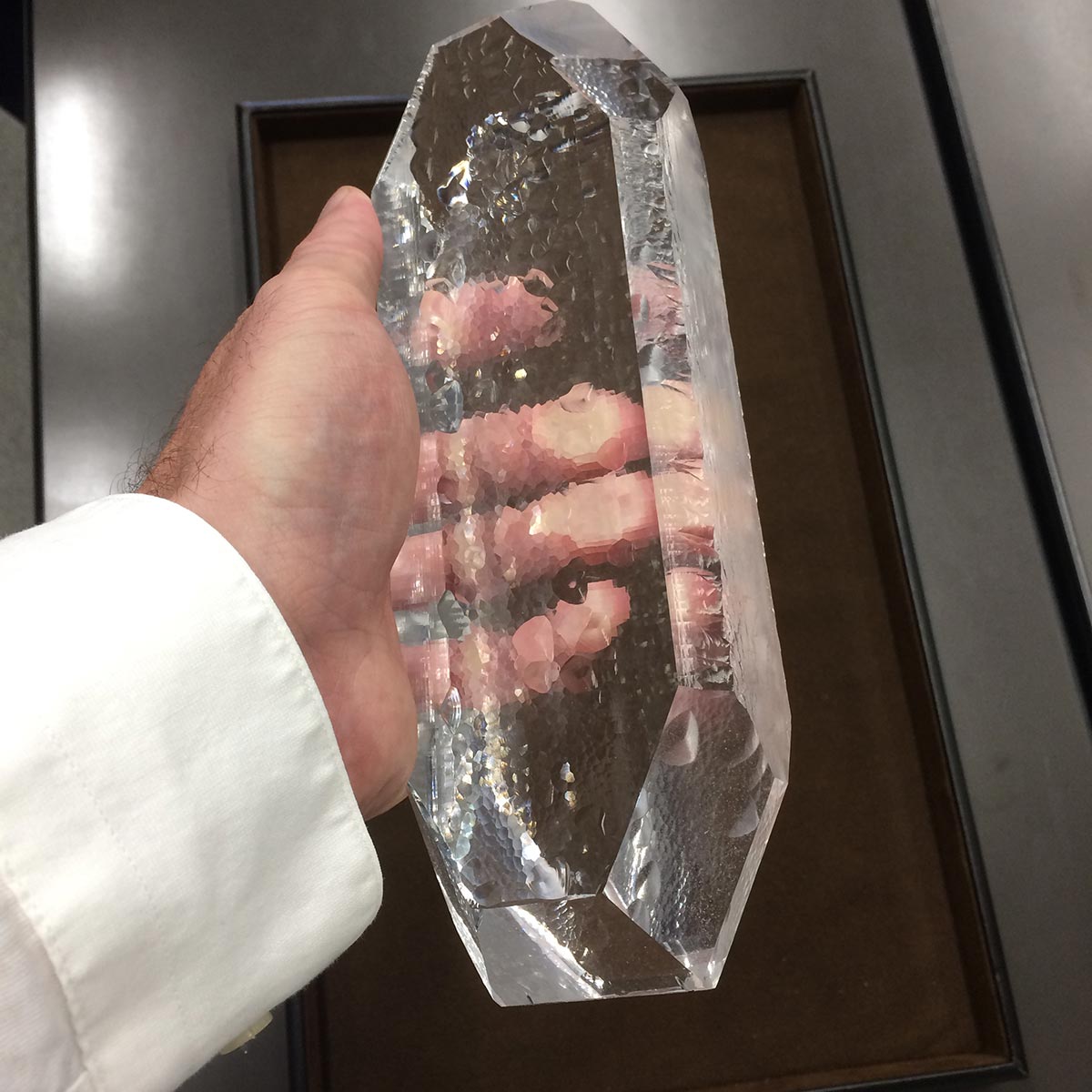
The regulating organ is rather complex. A Spring Drive movement utilizes an exclusive speed control mechanism, incorporating an IC, an electronic brake and a quartz crystal. Without a mechanism to adjust the speed at which the mainspring returns to its unwound state, it would unwind rapidly and the watch would come to an abrupt stop. To realize the goal of precise timekeeping, a mechanism to control the speed at which the spring unwinds is needed.
As its name suggests, the Tri-synchro regulator uses three types of energy to regulate the moving parts and establish synchronicity:
- Mechanical power, from the mainspring
- Electrical power, creating a reference signal via an IC/quartz oscillator
- Electromagnetic power, to apply a brake via a rotor/stator
These three forces work in harmony to regulate the way the spring unwinds and to enable the precise movement of the seconds hand. As a result, a Spring Drive movement has a power reserve of 72 hours and an impressive precision, with an average monthly rate of ±15 seconds (or ±1 second per day on average). The other advantage is having a seconds hand with an extremely fluid motion. See the video below:
In short, Spring Drive is impressive technology. Certainly less emotionally-driven than a mechanical movement, however, it offers multiple advantages. It isn’t a quartz movement you might find in a regular EUR 100 fashion watch. It is hybrid technology – something quite trendy these days – where a three-hand version still has over 200 mechanical components and a chronograph over 300.
Movement of the Snowflake SBGA211
Inside the titanium case of the Snowflake SBGA211 is the calibre 9R65, a movement entirely designed and produced by Seiko – including the home-grown quartz crystal. As mentioned, it features an automatic winding mechanism and a 72-hour power reserve. Functions include hours, minutes, seconds on the central axis, a date and a power reserve indicator. The movement also features a stop-seconds and can be manually wound (like all mechanical movements).
Looking through the sapphire caseback, the “non-mechanical” nature of this movement is rather difficult to spot. There is even a sort of “regulating” organ visible (in fact the driving wheel and glide wheel) and a non-watch expert could easily think he/she’s looking at an automatic watch.
As for the finishing and decoration, the movement is in line with the rest of the watch and offers a lot more than its price tag suggests. The bridges are nicely decorated with thick and deep ribbings and adorned with large, shiny bevels. Jewels and screws countersinks are also highly polished. Altogether, a decoration that is pretty impressive for a watch of this category.
Conclusion
Quality, precision, attention to details and versatility are the words that come to mind when looking at this Grand Seiko Spring Drive Snowflake SBGA211. We are genuinely impressed by this watch, by the execution of its case/bracelet, the beauty and subtle originality of its dial, the level of details of the hands, the comfort it offers as a daily beater and, dare I say it, the Spring Drive movement.
Certainly, this watch is more technical, less emotional, slightly colder than one of the new hand-wound, vintage-inspired Grand Seiko Elegance pieces. It is very “rational” and in this perspective, it succeeds. For someone on the hunt for a single luxury watch that will provide comfort, resistance to daily aggressions (and even more than that) and impressive precision, this is definitely a candidate to consider. It won’t appeal to the masses such as a Submariner or a Seamaster, however, on many levels, it is on par with these watches.
In addition to this, as watch snobs, we can say that Spring Drive technology is great. And it doesn’t hurt me to write it. Yes, it has a quartz oscillator but it is also highly mechanical and highly ingenious. One has to move with the times…
The Grand Seiko Spring Drive Snowflake SBGA211 is available at selected retailers and at the official Grand Seiko boutiques. It is priced at EUR 5,800 or USD 5,800. More details at www.grand-seiko.com.

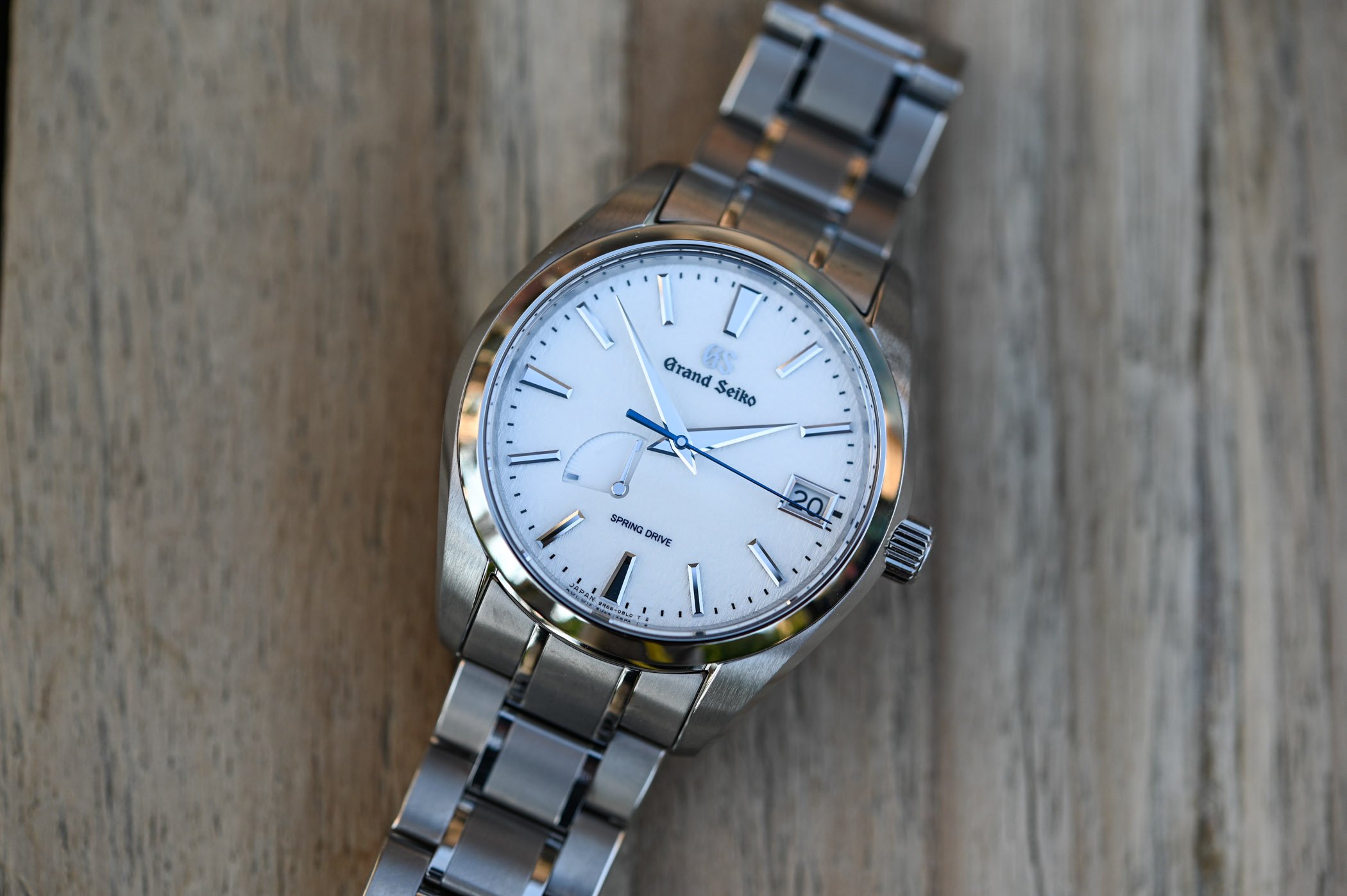
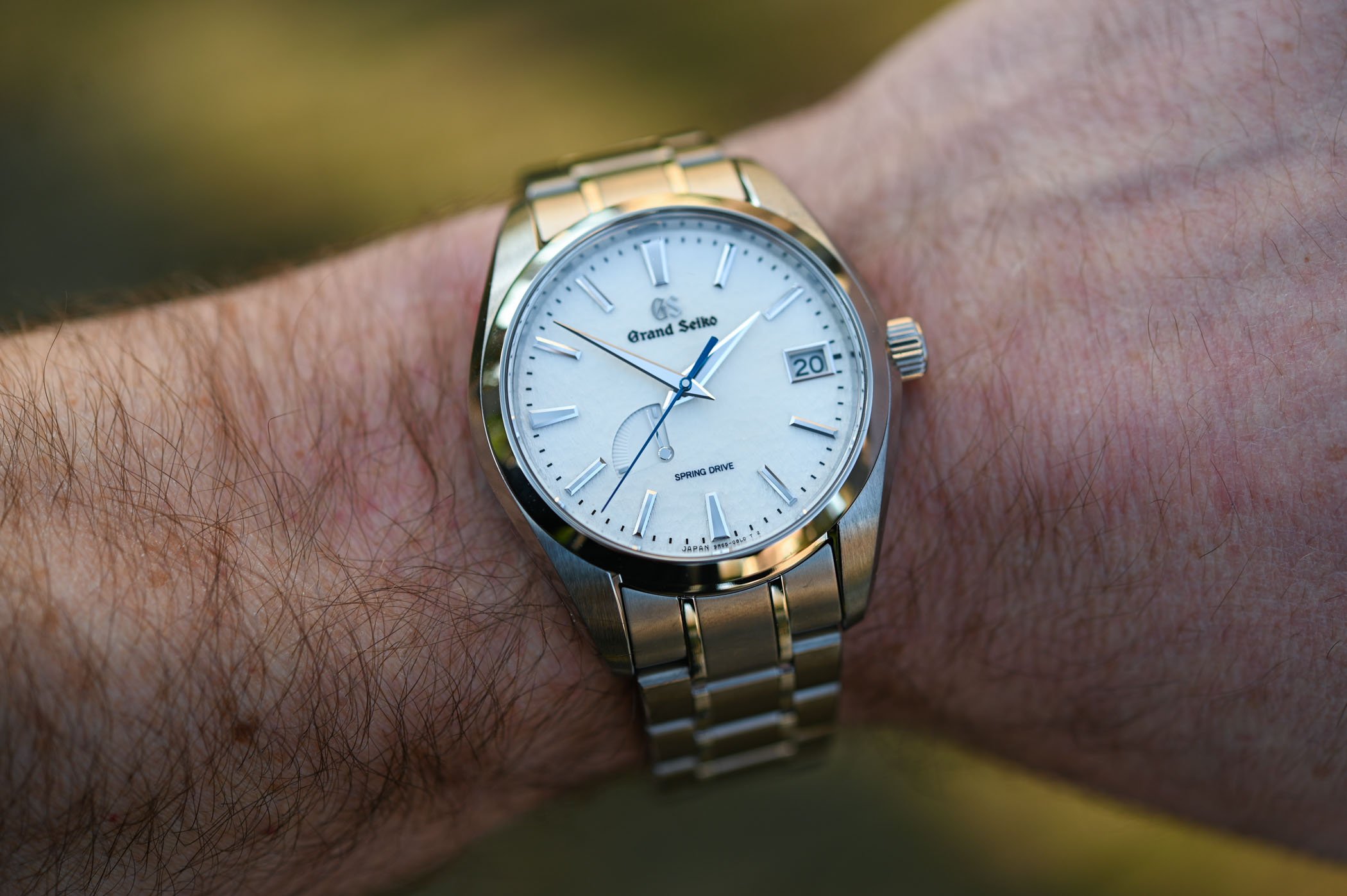
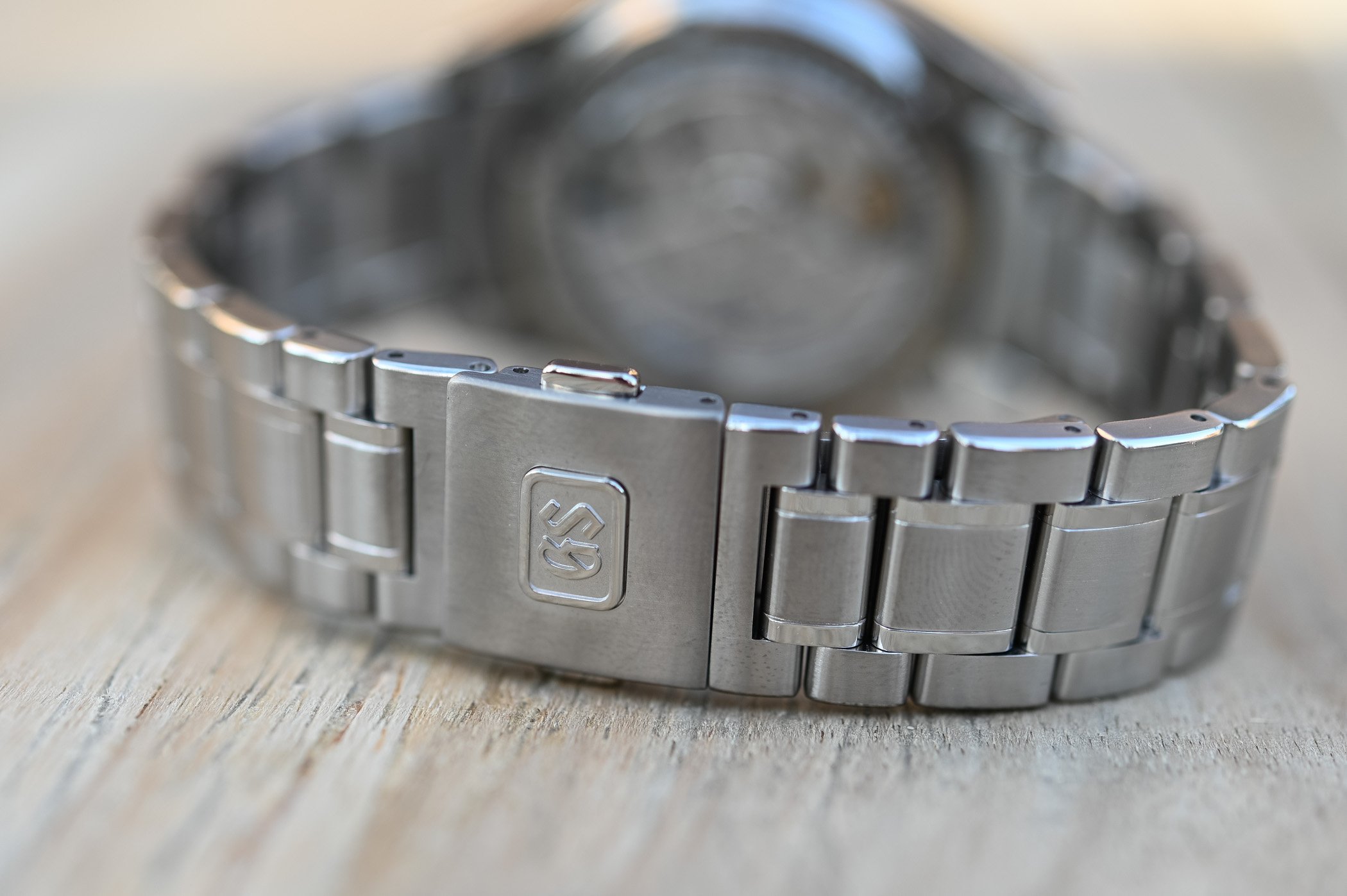
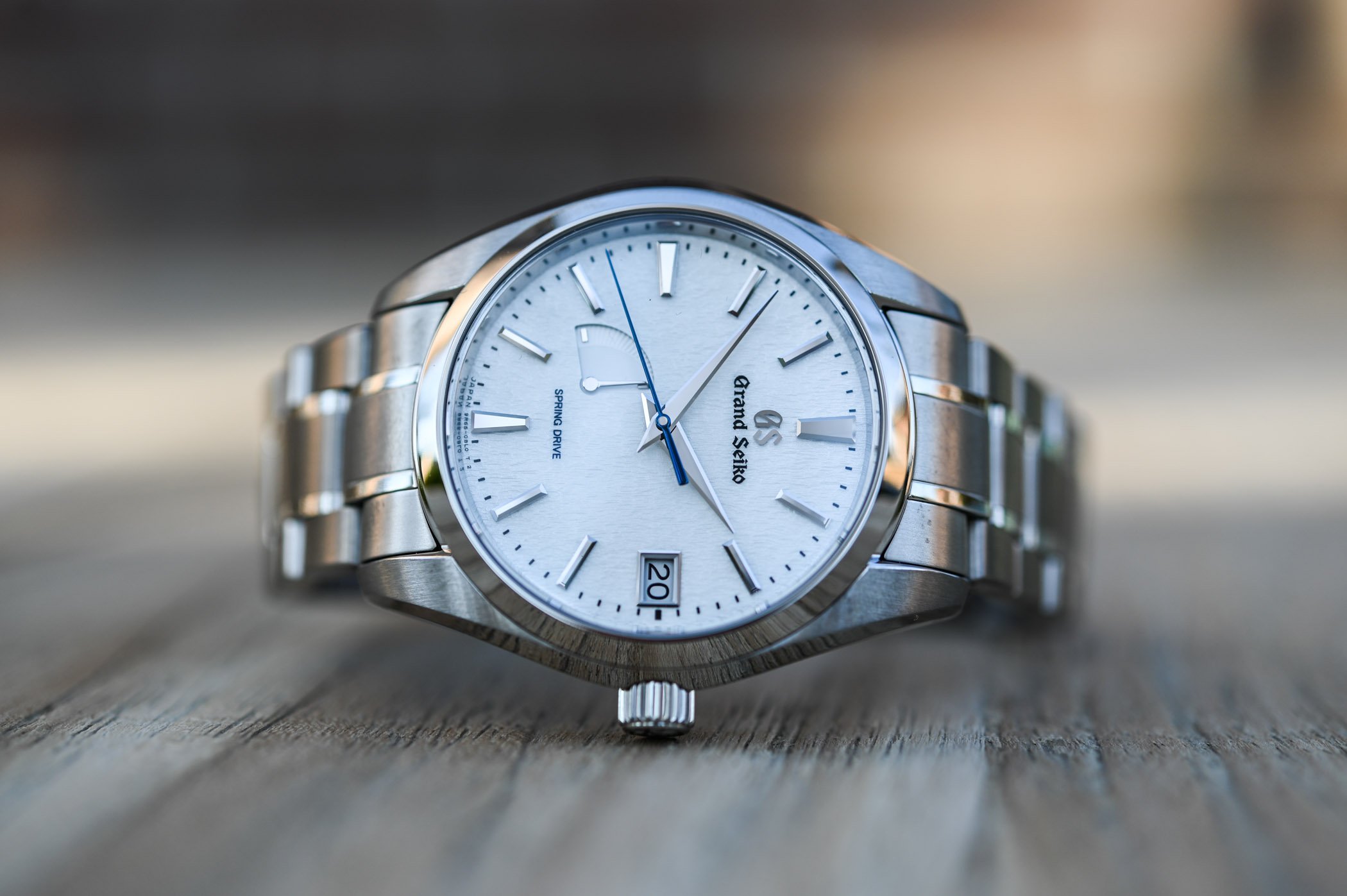
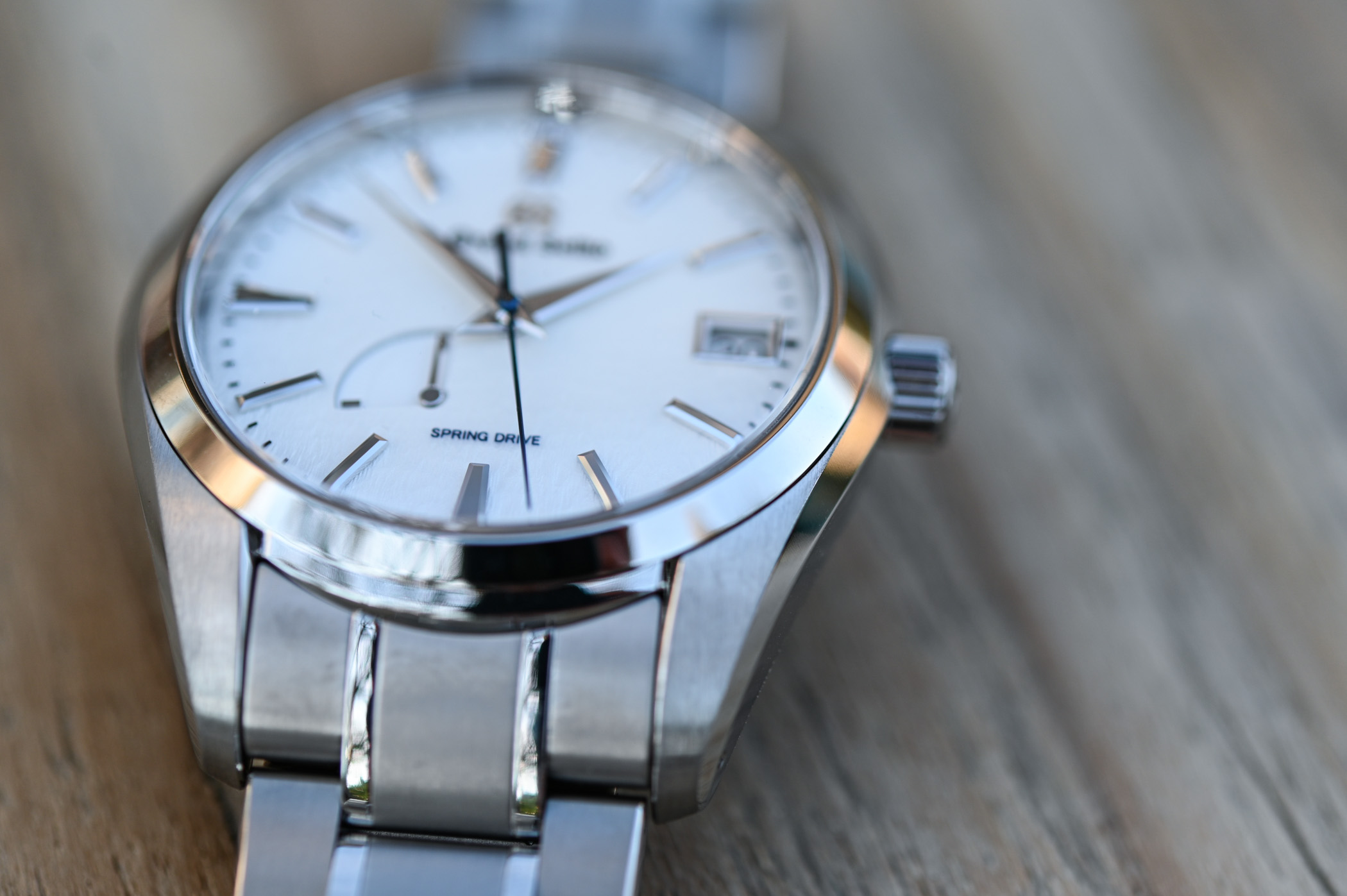
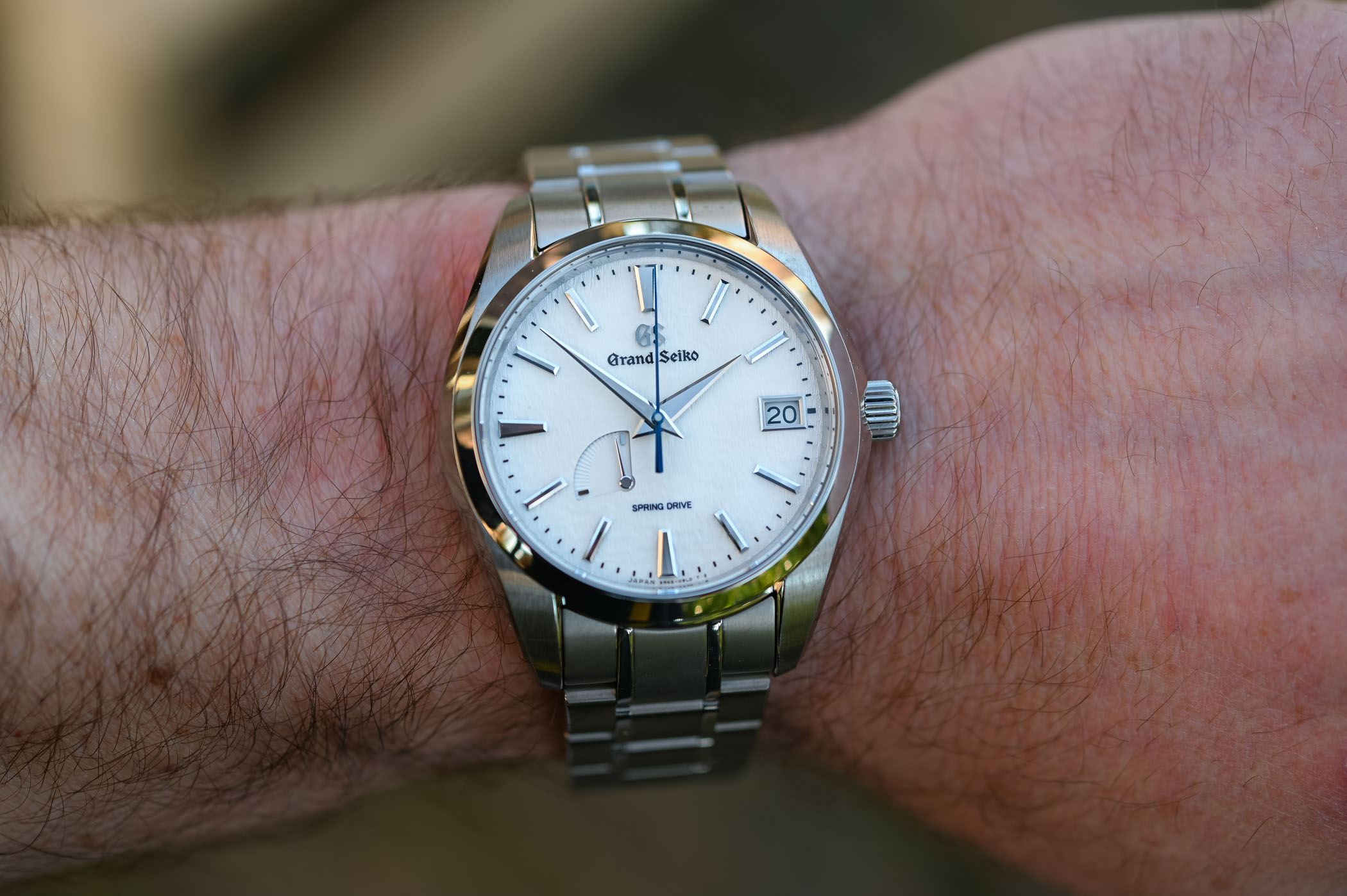
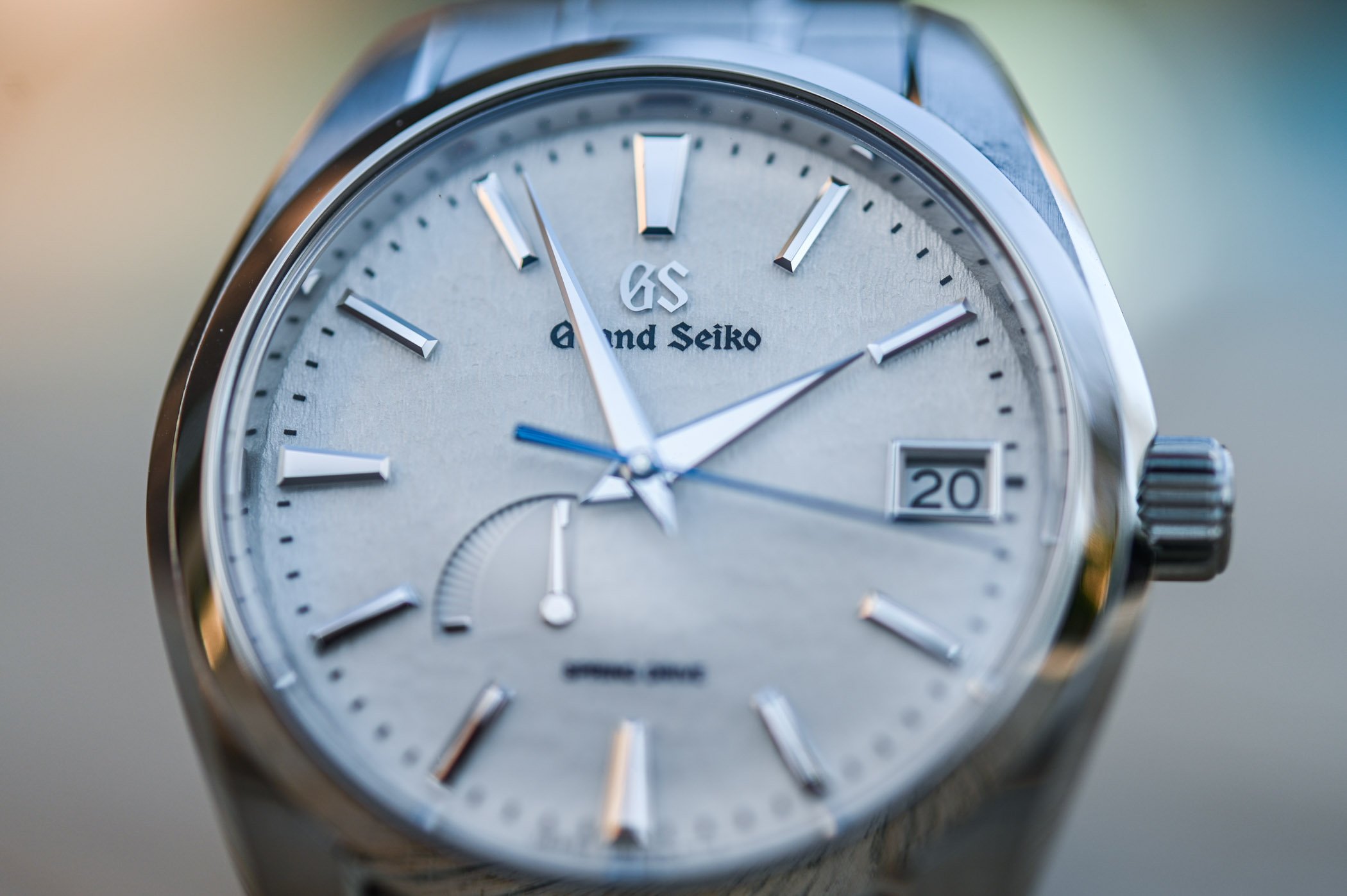
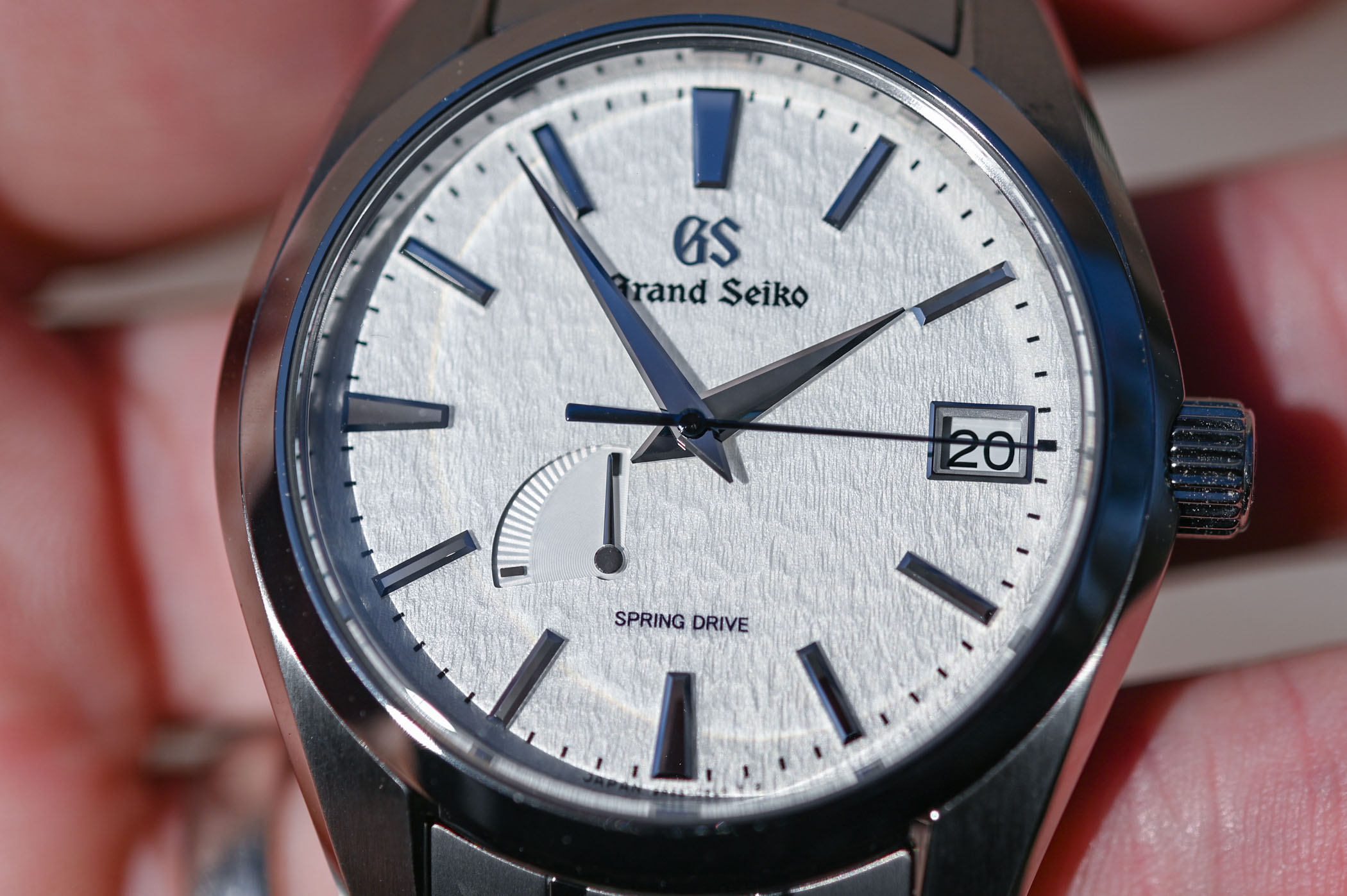
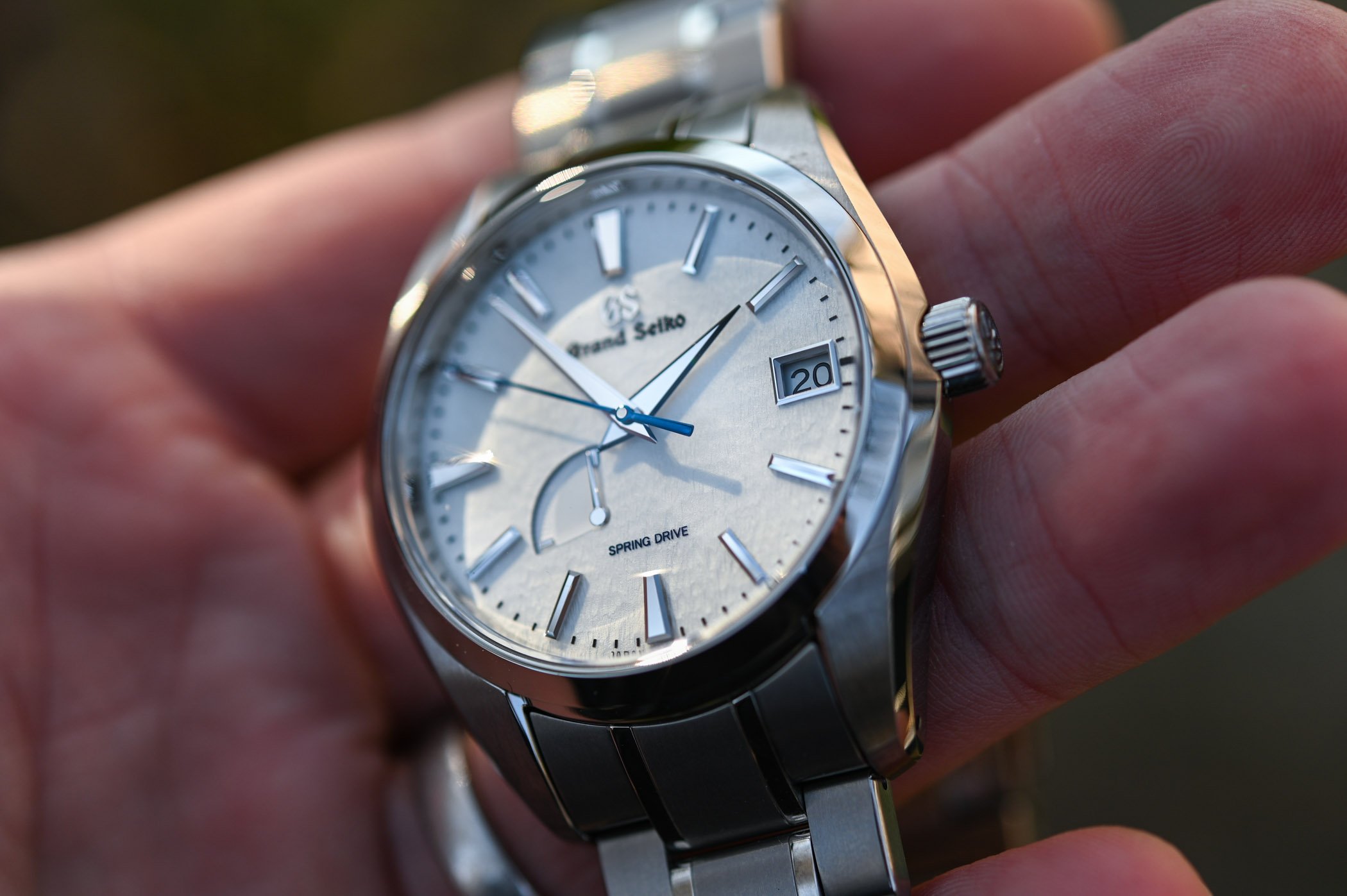
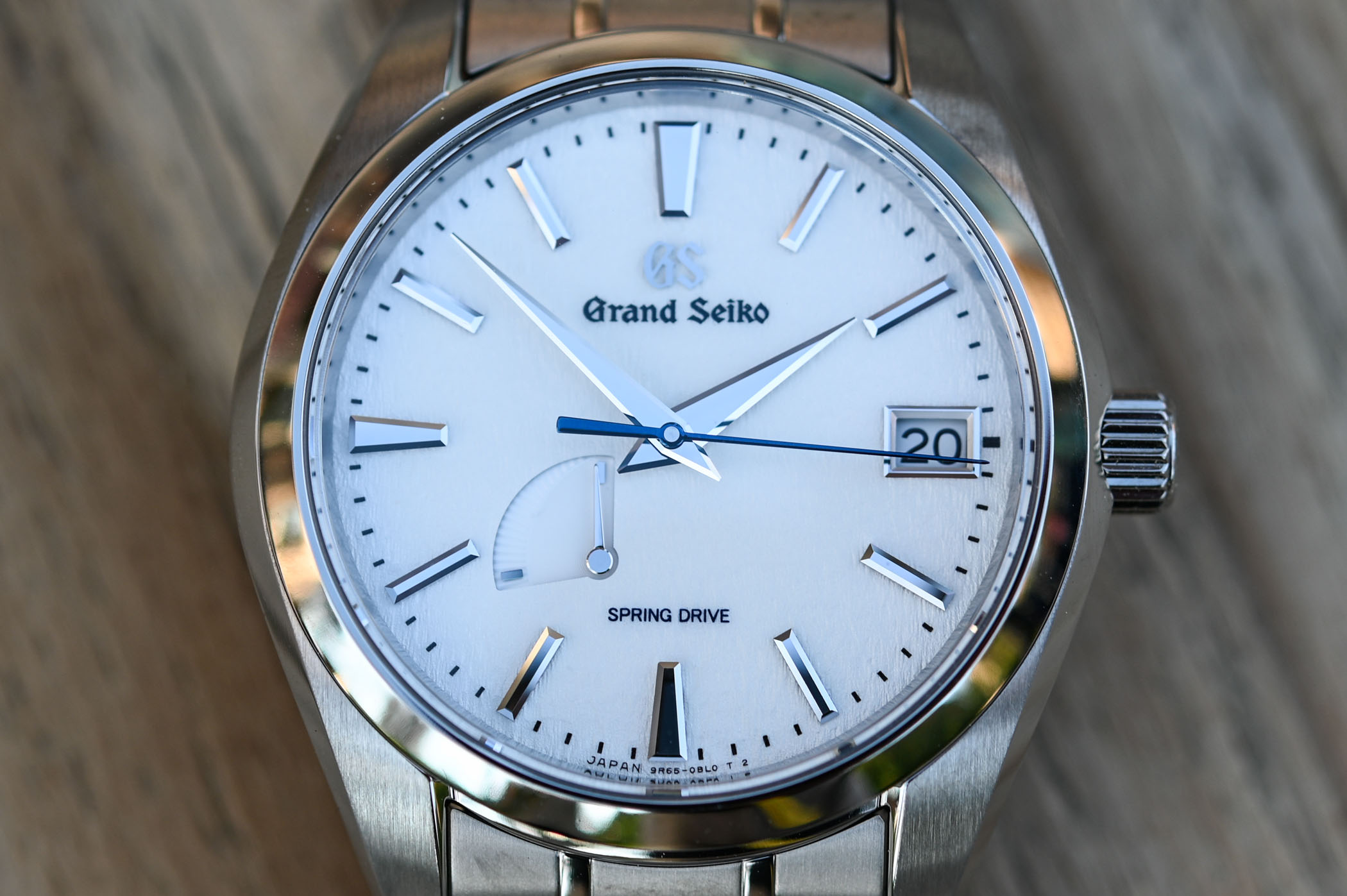
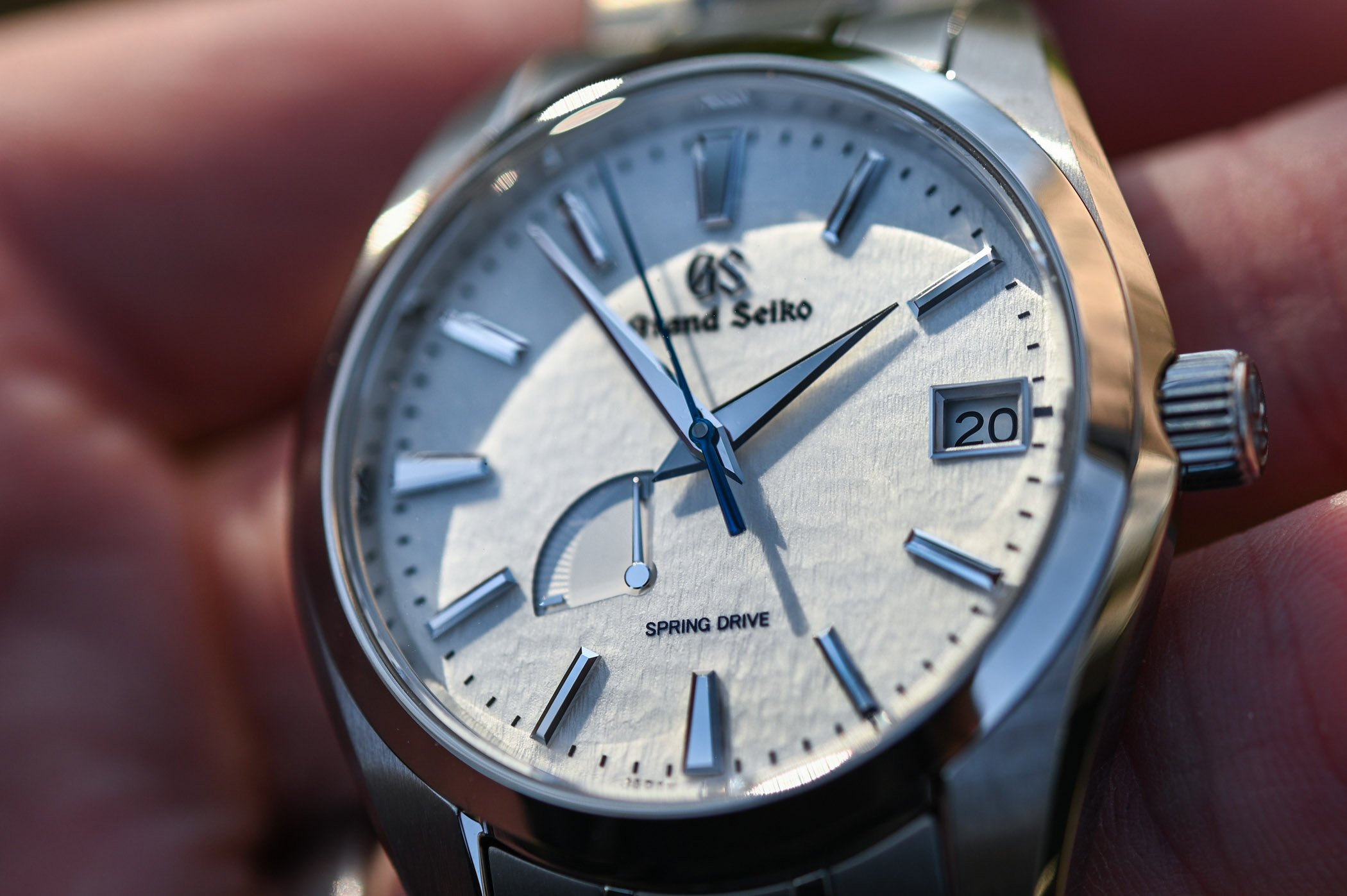
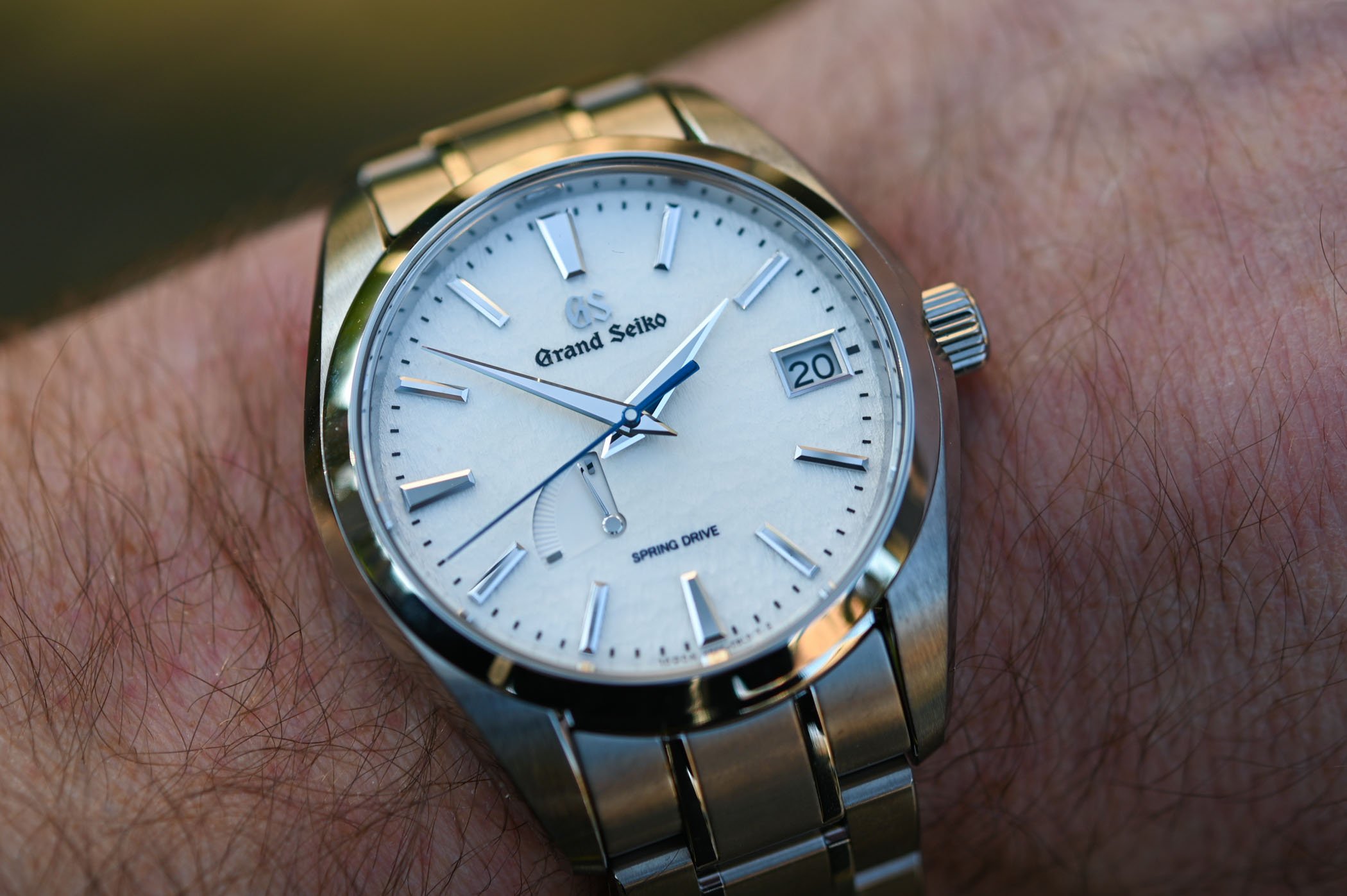
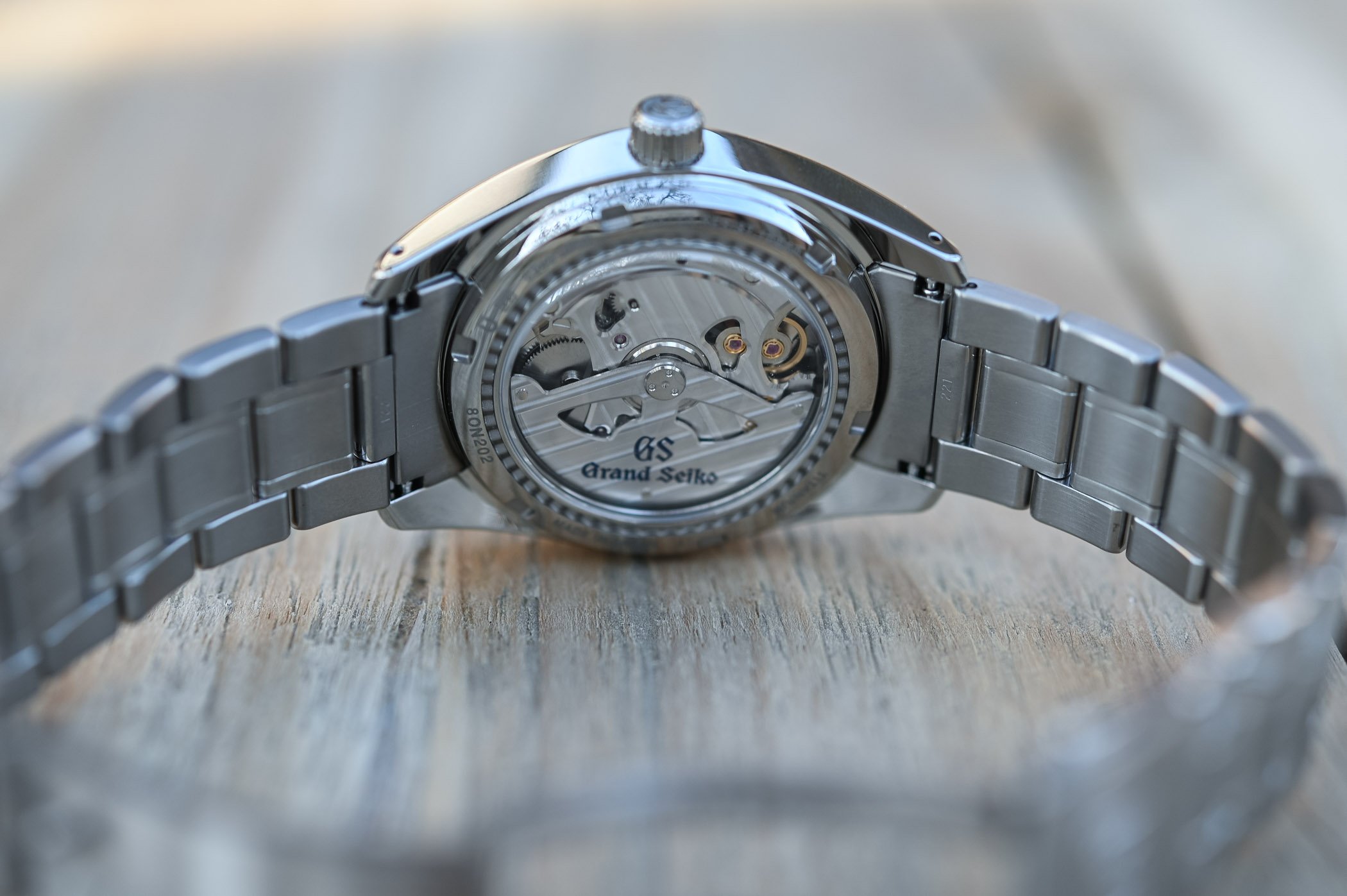
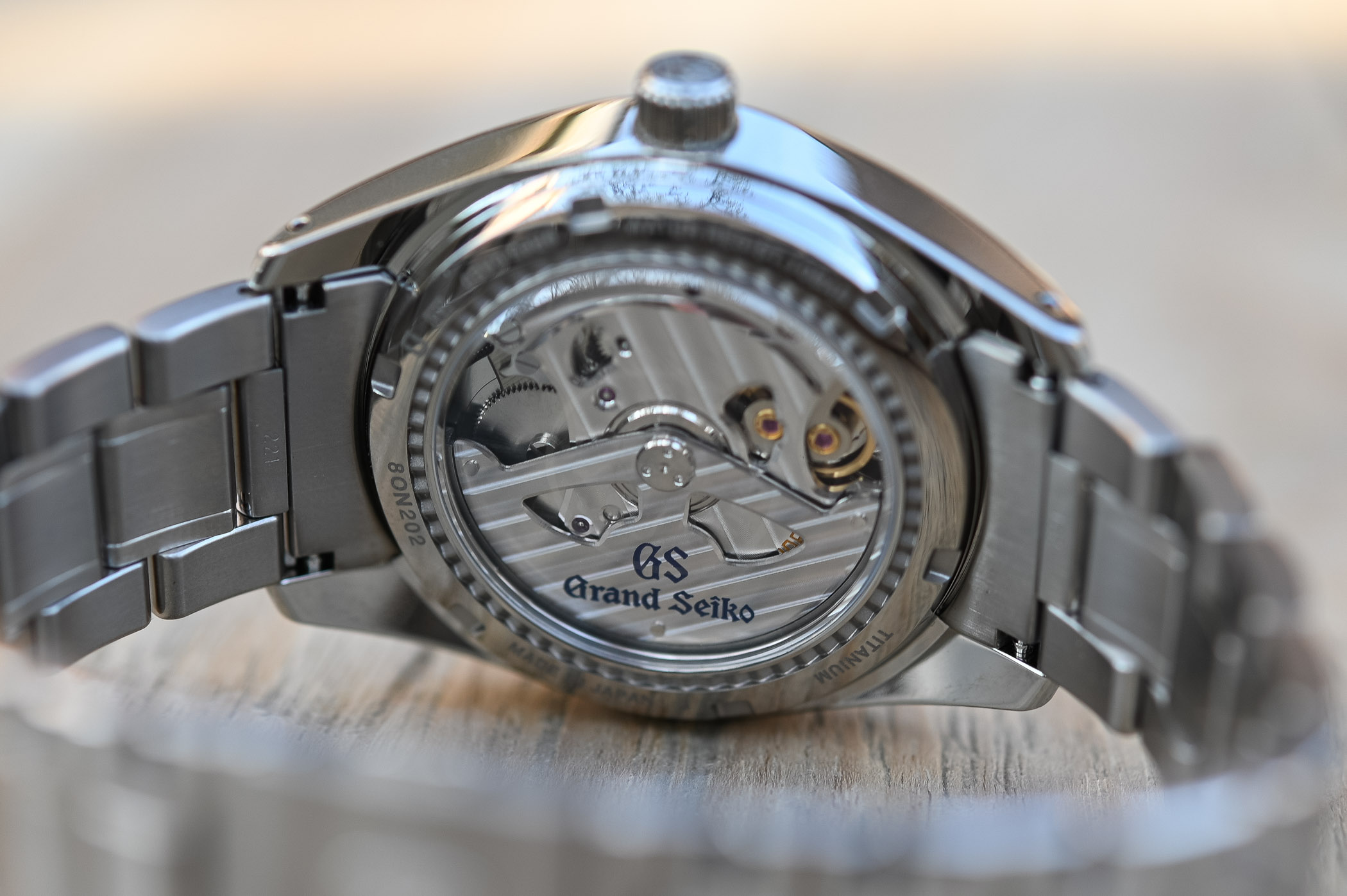
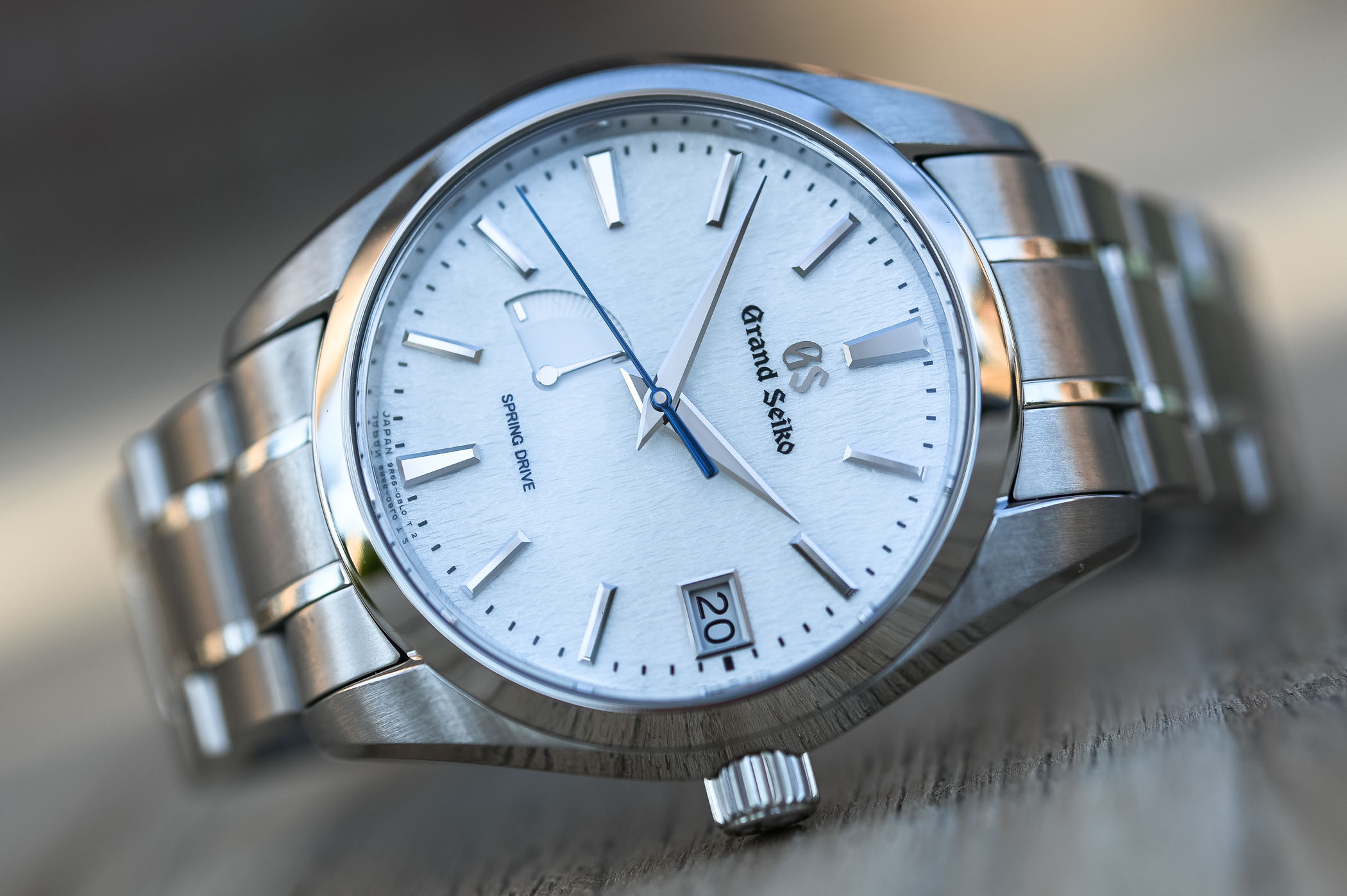



18 responses
Love the long detailed article. I would just like to point out that steel Grand Seiko models have screws in the bracelet. The titanium models have pins because the threading for screws doesn’t hold up in titanium.
The dial and hands are indeed up to Trinity standards, which make this a very attractive piece; and its accuracy is astounding. The case…well it’s fine for the price.
By the way, does the spring drive work on the same principle as Faraday’s Law of Induction?
I went to see the snowflake after I read and heard about it from many others.
This watch is truly for watch aficionados that pay extreme attention to details.
It isn’t a flashy piece to show off (except to other watch geeks) so it isn’t suitable for someone buying their first one or two mid-high end watches.
As for me, I was thoroughly impressed with Grand Seiko’s snowflake.
The smooth sweep of the blue second hand is amazing. The movement, the precision, the finish are all best in the business. Finally the dial and the lightness of the titanium material makes it really earn the ‘snowflake’ moniker.
Two observations. One, you overlook a key point on the bracelet. Grand Seiko still offers no quick-adjust on the fly as do Rolex, Omega, IWC and others. IMO, this is an oversight and places GS bracelets below other brands. Two, you mention that titanium is more scratch-resistant. It is not. Titanium is typically significantly softer than standard stainless steel, and can actually be scratched and dented easier than stainless steel. I believe GS may, however, use a surface hardening technique – not sure if they do so on the “snowflake”.
I would say you almost can’t find another watch with such great practicality(winding efficiency/weight/water resistance/accuracy) and visual interest(finishing/gliding second hand). Though it is pricier than GS hasn’t isolated, it’s still a great choice for a daily beater or the only “good watch”.
An interesting article. A unique concept carried out well by Seiko.I have a few of the cheaper Seikos
(battery dead on the Quartz one I took out of the drawer to correct the date on yesterday) and they all work well. However at the price I would be looking at Rolex, Breitling or Omega all of which have genuinely desirable offerings
I had a Rolex Submariner 50 years celebration watch bought new. After just 5 years it stopped working and it was sent to the factory for 4 months to repair. It cost me 10% of the new retail price and it was superbly done. I was worried about the high cost of maintaining it as a daily wearer so I changed it for a Omega Seamaster 300 co-axial, calibre 2500 that cost me half of the Rolex.
This proved to be a superb watch. After 6 years of continuous work, I was interested in trying the Grand Seiko that I read so great reviews and I changed the excellent Omega for a Snowflake. It is still brand new just 6 months old, so only time will tell how good it is, but for the last six months it is a super experience that did not wear out so fast like I had experienced before with the Rolex or the Omega.
Every day I am amazed with the mesmerizing movement of the blue second hand and the precision of this top movement, in my case 6 seconds too fast PER MONTH!
There are no other manufacturers that are selling a movement like this, so for me GS achieved something that is not only amazing but dare I say, priceless, with the proviso that it lasts a lifetime.
As for the emotional aspect, as I said before, it is stronger after six months than I recall from the two previous watches.
I have this piece and the smooth sweeping second hand is so therapeutic. I get almost no attention wearing it unlike my other more recognizable Swiss made pieces. There’s a saying… You wear GS to impress yourself and Rolex to impress others
Great article. One remark though… if your credo is reviewing haute horlogerie, than please make sure you do haute photography, meaning clean your watches first to pay respect to the manufacture. Regarding the Snowflake, I do own a selektion of Swiss watches in the same price bracket as the snowflake. After I bought the snowflake, and the honeymoon period was long over, I still cannot take it of because it’s such a mesmorising watch. You really have to spend enough time with it to fully appreciate this impressive watch. When first trying it on in the boutique, it was very nice, but as mentioned in some reviews, it is not a show off watch, not a flashy watch. But after some time spending with this Grand Seiko, you realise what a bargain it is, a haute horology watch at a Rolex price…
Would it be possible to write an article on the differance between Seiko spring dive and Seiko kinetic movements as I have three Seiko kinetic watches that in my opinion works in pretty much the same way as there spring drive except for the sweeping second hand. I am a Rolex and Seiko collector.
Thanks for any help.
While the watch as a whole isn’t my style, I do share everyone’s love for that smooth sweeping second hand. It makes even 36,000 hi-beat regular movements look clumsy. Having said that, I never understood the whole “watch-snob” thing against quartz. To me, the square G-Shock case or Pulsar LED is just as iconic as anything from Rolex or AP.
Thanks to Andrew Lock for his comments about the pins in the titanium bracelet.
Not only do most Grand Seiko use screws, Omega moved to the exact same setup as GS after they released the 8500 series: Two tiny screws and a middle pin to give the bracelet some lateral flex but still be easy to size and secure.
PS – I have the “baby” titanium GS (38mm) and it’s an amazing how nice the whole watch is when it weighs so little. My 2 other GS are nice too but I wish they were titanium.
This is a fine watch website and this is the first time you are touching upon spring drive? Wow. “One has to move with the times”. You are so far behind ….
I bought this watch 3 days ago. It is a fine timepiece but the titanium bracelet is not resistant to scratches. I am careful with my watches and tend to wear a long sleeve shirt but already I have one swirl and a small scratch. Super disappointing.
Probably the most innovative watch in horology today. I purchased one 6 months ago and it has become my favorite everyday watch out of large collection including a few Swiss/Euro brands (Rolex, Patek, JLC, AP, RM, etc.)
I thoroughly enjoy the subtleness of the watch and how I’m blown away from Grand Seiko’s attention to detail.
The snowflake is the watch connoisseurs guilty pleasure.
re:Vincent Prainito question on difference between Seiko Kinetic and Spring drive. With the Kinetic, the “self winder” charges a battery. Then the power from the battery runs a pretty much standard quartz movement. With Spring drive, the whole movement is pretty conventional mechanical, except instead of a balance wheel escapment, the regulator is a spinning wheel whose speed is controlled (braked) by the quartz circuit, and that braking energy powers the circuit.
Like Don Perley’s comment stated there’s no resemblance between kinetic and spring drive, totally different. As a daily workhorse I’m using a Seiko quartz kinetic and have to admit it works flawlessly, never an empty battery and accurate within 2 seconds/month! As I’m living on a tropical island it doesn’t have an easy life, gets a lot of seawater, but it’s holding up well over the last 4 years. Love the “mixture” of a spring drive and am curious how it will hold up in my daily life here, must try it one of these days
Kinetic drive is never mentioned in this as being another Seiko “system”. I’m using one in tropical conditionings as a daily runner for 4 years now and it’s performing flawlessly. And for the autor it’s good to know there were no battery changes.
Accuracy is within 2 seconds/month bracket….
Perhaps not as “warm” as mechanical…but still..